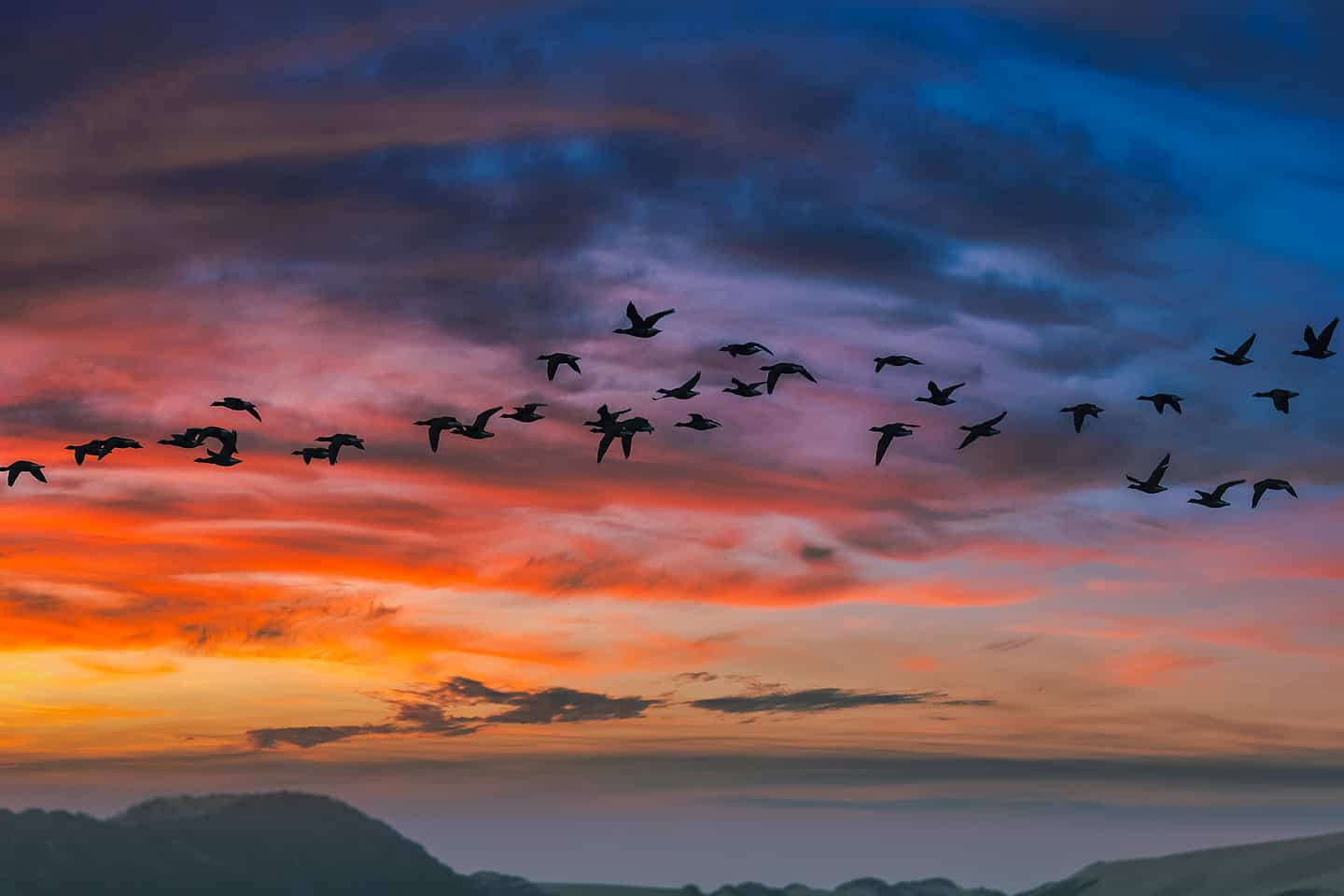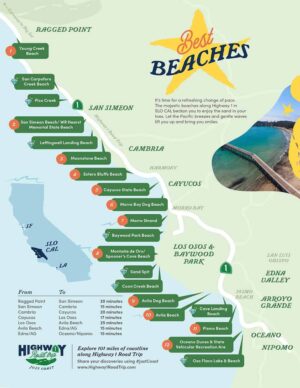Ideal climate, terrain, and proximity to the Pacific Flyway makes the SLO CAL stretch of Highway 1 one of the finest birding regions in the world. In fact, of the 1,107 bird species identified in the United States, 467 of those have been seen in San Luis Obispo County. (By way of context, the entire state of Wisconsin has only ever recorded 400 bird species.) Some of those include the peregrine falcon, red-tailed hawk, snowy plover, bird of paradise, barn owl, cooper’s hawk, cormorant and bald eagle. But there are many more obscure and rare species to add to your field journal as well.
Given this abundance, the Central Coast is a hot spot for bird watching enthusiasts, festivals, organizations and preserves. So pack up your binoculars, dust off your field guide, and read our Wildlife Viewing Tips before embarking on the birding trip of a lifetime.
What to bring birding on the Central Coast
Bird-watching can be thrilling here on Highway 1, but as with any adventure, preparation is key. To make the most of your visit, bring your best binoculars for close viewing, and/or a spotting scope for longer distances. A field guide like National Geographic’s Field Guide to the Birds of North America or Sibley Birds West can help with bird identification. Alternatively, a number of birding guide apps make identification easier than ever. Try the Audubon Bird Guide: North America, eBird, or Merlin Guide ID apps for comprehensive and reliable birding support. Several of these applications can ID birdsong, as well.
Prepare to record the numerous species you find here on a life list or field journal. (Many birding apps include journaling/listing options as well.) As for basics, pack bottled water and snacks in your backpack or birding pack. Wear layered clothing for weather that can vary widely from morning to evening. And don’t forget grippy shoes for hiking, as well as a wide-brimmed hat to protect your skin and to block the sun for a clear birding view.
Extra credit: If you’re traveling with a birding group, bring walkie talkies to make communication a breeze.
Morro Bay Winter Bird Festival
Held in January, the Morro Bay Winter Bird Festival offers world-class birding opportunities and education to 600 visitors each year. The four-day Winter Bird Festival includes 140 events and takes place in various locales in and around Morro Bay. Notable happenings include tours of various habitats, workshops, field trips, presentations and more, many of which are wheelchair-accessible. The festival appeals to new and veteran birders of all ages, and records around 200 species throughout the event. Some include: gulls, grebes, peregrine falcons, snowy plovers, blue herons, egrets, owls, raptors and even bats.
Additionally, several vendors offer artwork, books, field equipment and attire, and local merchant wares throughout the duration of the event. The Morro Coast Audubon Society sponsors the Winter Bird Festival in partnership with the City of Morro Bay and California State Parks.
Birding in Morro Bay and Baywood
The area surrounding Morro Bay and Baywood is a designated State and National Estuary, and a Globally Important Bird Area. Up to 20,000 shorebirds spend the winter on the exposed mudflats around Morro Bay, making it one of the most significant migration stopovers in the state, south of San Francisco. It is home to around one-third of the Western Snowy Plover population, as well as several other species. Some include the Long-billed Curlew, Black Rail, Short-Eared Owl and Northern Harrier, and Bell’s Sage Sparrow. Perhaps most famously, the Morro Rock hosts a nesting pair of Peregrine Falcons.
Perregrine Falcon Video
There are a pair of nesting perrigrine falcons living on Morro Rock. The perrigrine falcon is the fastest animal on earth clocked at 240 miles per hour.
In Los Osos, Pecho Road and the Elfin Forest at Baywood Park provide critical stopover points for several species of migrating birds. Another way to add more birds to your life list is by birding on the Morro Bay Estuary that fronts Baywood Park. There’s no better or more immediate way to explore this area’s population of sea birds.
Black Brant Geese
One of the most popular birds to glimpse in Los Osos-Baywood Park is the Black Brant, a migratory subspecies of geese. With their striking black coloring and white markings on the neck, the Black Brant has been known to fly over 3,300 miles in a season. Home base for these athletic geese is the Arctic’s Izembek Lagoon, but they can travel as far as Baja, Mexico during migration. Those that visit Los Osos-Baywood Park are particularly attracted to the eelgrass that grows in the Morro Bay Estuary. One of the best viewing spots for these geese is the birdwatching platform at the end of Broderson Avenue in the Sweet Springs Nature Preserve. Interested in seeing Black Brants, along with many other native and migratory bird species? Attend the Morro Bay Bird Festival, a winter bird watching event that attracts bird-lovers from all over the world.

Bird Watching Cambria
While good birding can be found throughout the quiet town of Cambria, two spots are particularly good. Both are in and around Santa Rosa Creek. To reach this area, drive north on Highway 1 into Cambria. At Windsor Blvd, turn west (left) and continue on Windsor Blvd.
To reach the mouth of the creek, turn right onto Moonstone Beach Drive and park on the left after 0.4 miles. Look and listen for ducks and gulls near the creek mouth, in the rocks offshore, or on the beach.
To reach the Santa Rosa Creek bed, after turning at Windsor Blvd, cross the bridge and park near the small water treatment facility on the left. A trail follows the edge of the creek upstream before climbing a hill. Here, among the willows, watch and listen for wintering warblers.
Bird Watching Montana de Oro
The hiking, cycling and equestrian trails at Montana de Oro State Park travel through some of SLO CAL’s best birding zones. Reach Montana de Oro by traveling west on Los Osos Valley Road, through the Los Osos business district. This becomes Pecho Valley Road and turns south to the park’s entrance. The following birding spots are in their marked order from the park entrance.
Sand Spit comprises coastal scrub in which Wrentits, California Thrashers and Blue-Gray Gnatcatchers. Beyond the scrub to the beach, watch for shorebirds and Surf Scoters past the wave-line.
At Hazard Canyon, find Warblers in the willows in winter, or perhaps a Winter Wren. Past here, the rocky shoreline hosts Wandering Tattlers, Black Oystercatchers and surfbirds. In the ocean, look for Shearwaters and Alcids here for winter migration.
At the Islay Creek Mouth, look for plenty of gulls in the winter. In fall, when the morning sun first shines on the willows, look for Chipping and Clay-colored Sparrows, or Warblers.
At Spooner’s Cove Campground, look for cypress, pine and willow trees to identify wintering Warblers. Other species here include Purple Finches, Golden-Crowned Kinglets and Woodpeckers. Fox Sparrow, White-Throated Sparrows, Wrentits, and California Thrashers are known to winter here, too.
The Bluff Trail sees Cormorants on the rock below, as well as Pigeon Guillemots nesting in the cliffs. Look to the sea for Alcids and Shearwaters. The shoreline is a good place to look for Black Turnstone, Surfbird, Wandering Tattler and Black Oystercatcher.
Take the Coon Creek Trail to see Grosbeaks and Thrushes in the coffee berry bushes when ripe. In the willows along the trail, find Winter Wrens in the spring, as well as Canyon Wrens above the trail to the right. Other species along this trail are Warblers, Pacific-Slope Flycatchers, Fox Sparrows, Wrentits, Hermit Thrushes and Swainson’s Thrushes.
Bird Watching Estero Bluffs
This beautiful state park north of Cayucos comprises a trail that parallels the coastline. This can be accessed by several connecting trails from parking areas along Highway 1.
From the “Windmill” or San Geronimo Road pullout, find Sparrows and Warblers in the scrub near the parking area. Closer to the water, check for Cormorants, Black Oystercatchers, Elegant and Royal Terns, Surfbirds, Tattlers and Black Turnstones. In particular, winter sees Ruddy Turnstones, Scoters, Grebes, Harlequin Ducks, Alcids, Marbled Murrelets and Cassin’s Kingbirds in the eucalyptus by the windmill. These species can also be found at the next parking area to the north, where an enormous fig tree stands at the trailhead.
A less robust selection of these same species can also be witnessed at the Villa Creek parking area, north of the Fig Tree trailhead. Here, however, is a Snowy Plover nesting area, walking north along the Estero Bluffs Trail.
Bird Watching Ragged Point
For good birding near Ragged Point, take the steep Cliffside Trail just north of Ragged Point Inn. The Black Swift Falls waterfall to the side of this trail is the only place in San Luis Obispo County to host nesting Black Swifts. The best time to see these birds is early morning or evening, while they’re feeding in the hills or flying in the sky. You can also find Purple Finches and Olive-Sided Flycatchers in the cypress trees there in summer.
Along the challenging Fire Road Trail, just across Highway 1 from Ragged Point Inn, Pygmy Owls have been found on the higher slopes there.
Bird Watching San Simeon
A number of excellent birding areas can be found in and around San Simeon. At the William Randolph Hearst Memorial State Beach, spy Grebes and Scoters from the end of the pier. Also keep an eye out for Marbled Murrelets, as well as Pigeon Guillemots nesting under the pier. From the parking lot, head north on SLO San Simeon Road. At the bridge, look for migrants, and north of the bridge, Hummingbirds and Orioles in the red-flowered eucalyptus trees.
At Arroyo Laguna Creek, 2 miles north of Hearst Castle, look for Ducks and Shorebirds on the creek from the bridge.
Driving north on Highway 1 from here, look for the mile marker 61.2 and park on the western side of Highway 1. Look for the small stand of Monterey cypresses to the south. Here, you may see shorebirds near the coastal rocks, as well as sea ducks and Harlequin Ducks.
Continuing north to the Elephant Seal Rookery, find gulls here in winter, or Glaucous-Winged, Mew, and Herring.
Just under a half-mile north of the Rookery, in a parking lot on the west side of Highway 1, find the whitewashed rock of Piedras Blancas through the gate and 0.2 miles along the trail. Look for Brown Booby on the rock on winter mornings.
Arroyo de la Cruz is an area just over 4 miles from the Piedras Blancas turnout. Park off the road, slightly north of the tall bridge. Take the steep trail at the northwest end of the bridge to a willow-framed trail. These willows can house migrant Passerines. Good birding can also be had as the trail opens up to pools, beach and more willows.
San Carpoforo Creek is another 4.5 miles north of Arroyo de la Cruz. Park off the road and find the trail that winds to a lagoon and the beach. In fall, find Black-and-White Warblers, Reddish Egrets, and Summer Tanagers.

Bird Watching Avila Beach
Avila Beach boasts a number of bird-watching lookouts, and walking the Bob Jones Trail is a relaxing and scenic way to find some of them. Along the trail, look for Black-Headed Grosbeaks and Bullock’s Orioles, and find migrants in the willows. Check pools along the stream for Hooded Mergansers, Common Goldeneyes, Cormorants, Herons and Egrets in winter.
At the Cal Poly Pier, look to the rocks for shorebirds, Rock Sandpiper, Seaducks, Loons and Grebes.
On the Harford Pier, check for Seaducks, Loons and Grebes. The harbour can also host Red-Necked Grebes, White-Winged and Black Scoters, Long-Tailed Ducks and Shorebirds.
Bird Watching Oceano & Oso Flaco Lake
The area comprising Pismo Beach State Park and the Oceano Lagoon and Campground are considered some of the best birding in SLO CAL and, indeed, in California. Park just off Highway 1 on Pier Avenue and walk north along the trail. In particular, Oceano is known for its Passerines and Warblers during the winter migration. Just a handful of species to be seen here include Yellow-Throated Vireos, Blackburnian Warblers, Ovenbird, Baltimore Oriole, and Summer Tanagers. Walkie-talkies are a good idea here as birders tune in to 11.22 to communicate with each other on species they find.
Another top birding area in the state is Oso Flaco Lake, south on Highway 1 toward Nipomo. Take Highway 1 off the Nipomo mesa turning west on Oso Flaco Road. Drive all the way west until the road dead ends into a day-use parking lot. (There is a fee for parking and using the park.) Along the trail, find Warblers, Passerines, and Waterfowl in winter, as well as Soras, Virginia Rails and American Bitterns. Swallows can be seen in late summer and early fall. From May to August, you’ll see Least Terns nesting on the beach, especially by the boardwalk rails. In the coastal scrub, see California Thrashers, Blue-Gray Gnatsnatchers, and Wrentits. Then on the beach, find Scoters, Loons, Grebes and Sooty Shearwaters in fall and winter, as well as gulls and shorebirds.
Bird Watching Lopez Lake
In and around the Lopez Lake Recreation Area, a number of hard-to-find species make the birding extremely good. Heading toward the lake, it’s easy to spot wild turkeys, Hutton’s Vireos, Acorn Woodpeckers and Oak Titmice. Past the fee station and through the campground, the edge of the lake provides most of the birding action. This section of the lake can see a wide variety of ducks, grebes, and shorebirds. It’s also not uncommon to see Ospreys and Bald Eagles, which breed here.

Stewardship travel for good
The birding is top-notch along our particular stretch of Highway 1, but occasionally wildlife-seekers find injured birds or other animals that need rehabilitation. Pacific Wildlife Care is a nonprofit center that cares for hurt or ill birds, mammals and reptiles. If you see an animal in distress, call the Pacific Wildlife Care hotline at 805-543-9453, or to donate, visit Pacific Wildlife Care


